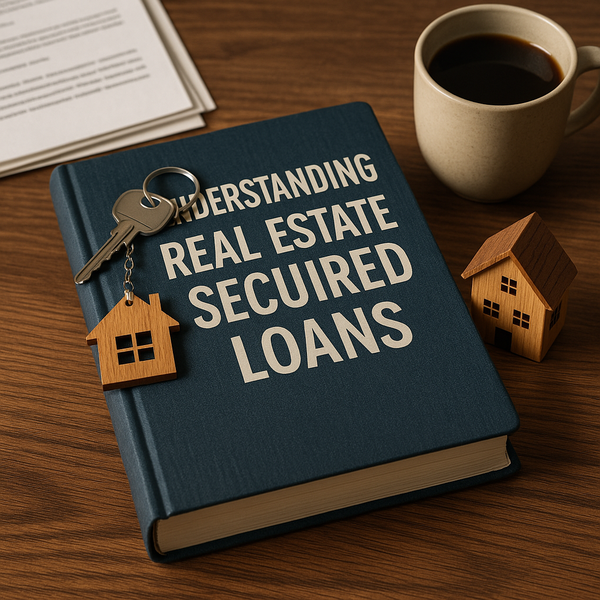
Real estate secured loans offer homeowners a way to borrow money using the value of their property as collateral. This type of financing is distinct from unsecured loans, where no asset backs the debt. By leveraging home equity, borrowers may access larger sums or potentially more favorable terms compared to other loan types.
What is a Real Estate Secured Loan?
A real estate secured loan is a type of debt where the borrower pledges real property, such as a house, land, or commercial building, as collateral. This means the lender has a legal claim on the property if the borrower defaults on the loan. The most common example of a real estate secured loan is a mortgage, used to purchase the property itself. However, other types allow homeowners to borrow against the equity they have built in their home, such as home equity loans and Home Equity Lines of Credit (HELOCs). Because the loan is secured by a valuable asset, lenders typically view these loans as less risky than unsecured loans like personal loans or credit cards. This reduced risk can often translate into lower interest rates and potentially higher borrowing limits than might be available with unsecured financing options. The amount a person can borrow is usually a percentage of the property's market value, minus any outstanding mortgage balance, known as the loan-to-value (LTV) ratio. Lenders assess this ratio, along with the borrower's credit history, income, and other financial factors, to determine eligibility and loan terms. The repayment structure can vary, with fixed-rate loans offering predictable monthly payments and variable-rate loans having payments that fluctuate based on market interest rates. Understanding the specific terms, including interest rates, fees, and the repayment schedule, is crucial before committing to a real estate secured loan.
Types of Real Estate Secured Loans
Beyond the primary mortgage used for purchasing a home, several other types of real estate secured loans are available, primarily allowing homeowners to access their accumulated equity. A **Home Equity Loan** is a second mortgage where the borrower receives a lump sum of money upfront. The loan is repaid over a fixed term, typically 5 to 30 years, with a fixed interest rate, resulting in consistent monthly payments. This structure makes budgeting predictable and is often suitable for large, one-time expenses like major renovations or debt consolidation. The second common type is a **Home Equity Line of Credit (HELOC)**. Unlike a home equity loan, a HELOC functions more like a revolving credit line. The borrower is approved for a maximum borrowing amount (the credit limit) and can draw funds as needed during a specified draw period, often 10 years. During the draw period, payments might be interest-only. Once the draw period ends, a repayment period begins (often 20 years), during which the borrower must repay the principal and interest, usually with variable payments as the interest rate is often variable. HELOCs offer flexibility for ongoing or unexpected expenses. Another type is a **Cash-Out Refinance**. This involves replacing your existing mortgage with a new, larger mortgage and taking the difference in cash. This is often used when interest rates have dropped or to consolidate debt, but it means your primary mortgage is now larger. Reverse mortgages are also a type of secured loan specifically for older homeowners (typically 62+) that allows them to convert a portion of their home equity into cash; repayment is usually deferred until the borrower moves out, sells the home, or passes away. Each type has different structures, pros, and cons, making it essential to assess individual financial needs and goals to choose the most appropriate option.
Pros and Cons of Leveraging Home Equity
Utilizing a real estate secured loan by leveraging home equity comes with significant potential benefits but also notable risks. On the positive side, these loans often feature lower interest rates compared to unsecured personal loans or credit cards because the collateral reduces the lender's risk. This can make borrowing large sums of money more affordable. The interest on home equity loans and HELOCs may also be tax-deductible if the funds are used for home improvements, although tax laws are complex and borrowers should consult a tax professional. These loans provide access to substantial amounts of cash, making them suitable for major expenses like home renovations, education costs, medical bills, or consolidating high-interest debt, potentially simplifying finances and reducing overall interest paid. The flexibility of a HELOC, allowing draws as needed, can be particularly useful for ongoing projects or emergency funds. However, the primary drawback and risk is that your home serves as collateral. If you fail to make payments, the lender has the right to foreclose on your property, meaning you could lose your home. This risk is significantly higher than with an unsecured loan. Additionally, these loans come with fees, such as appraisal fees, closing costs, and potentially annual fees for HELOCs, which can add to the overall cost. If property values decline, you could end up owing more than your home is worth (being underwater on the loan), making it difficult to sell or refinance. Borrowing against your home equity also reduces the equity you have built, which is a portion of your personal wealth. Therefore, while powerful financial tools, real estate secured loans require careful consideration of your financial stability and the potential consequences of default.
Eligibility and Application Process
Qualifying for a real estate secured loan, whether a home equity loan or HELOC, typically involves meeting specific criteria set by lenders. The most critical factor is having sufficient equity in your home, meaning the property's market value is significantly higher than the outstanding balance on your primary mortgage. Lenders usually require a minimum amount of equity, often 15% to 20%. Your credit score is another crucial element; a higher score generally improves your chances of approval and securing a better interest rate. Lenders will review your credit report to assess your borrowing history and repayment reliability. Your debt-to-income ratio (DTI), which compares your total monthly debt payments to your gross monthly income, is also a key factor. A lower DTI indicates you have more income available to cover additional debt payments, making you a less risky borrower. Lenders have specific DTI limits they adhere to. The application process typically involves providing documentation to verify your income (pay stubs, tax returns), assets, and information about the property (appraisal, title information). The lender will conduct a property appraisal to determine its current market value and a title search to ensure there are no liens or ownership disputes. Once your application is submitted and documentation is reviewed, the lender evaluates your financial profile and the property's value to determine the loan amount you qualify for, the interest rate, and other terms. This process can take several weeks, similar to obtaining a primary mortgage. It is advisable to shop around and compare offers from different lenders, considering not just the interest rate but also fees, repayment terms, and customer service. Understanding all aspects of the loan agreement before signing is paramount.
Conclusion: Making an Informed Decision
Real estate secured loans, including home equity loans and HELOCs, offer homeowners valuable options for accessing capital by leveraging their home's value. They can provide access to larger loan amounts and potentially lower interest rates compared to unsecured borrowing methods, making them attractive for significant financial needs like home improvements, education, or debt consolidation. However, the fundamental characteristic of these loans—using your home as collateral—introduces a significant risk. Defaulting on payments can lead to the loss of your property through foreclosure. Before pursuing a real estate secured loan, homeowners should carefully evaluate their current financial situation, future income stability, and the purpose for which the funds are needed. Understanding the different types of secured loans, their specific terms, interest rates, fees, and repayment structures is essential. Comparing offers from various lenders and consulting with a financial advisor can provide valuable insights and help ensure that a real estate secured loan is the right financial tool for your circumstances and that you are prepared for the responsibilities involved. Making an informed decision is key to safely utilizing the equity in your home.

